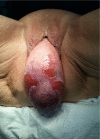Outcomes of vaginal hysterectomy and constricting colporrhaphy with concurrent levator myorrhaphy and high perineorrhaphy in women older than 75 years of age
- PMID: 26150705
- PMCID: PMC4484673
- DOI: 10.2147/CIA.S85960
Outcomes of vaginal hysterectomy and constricting colporrhaphy with concurrent levator myorrhaphy and high perineorrhaphy in women older than 75 years of age
Abstract
Objectives: We performed constricting anterior and posterior colporrhaphy, levator myorrhaphy, and high perineorrhaphy with concurrent hysterectomy, and investigated the intraoperative complications, and short-term outcomes of these constricting procedures in patients aged 75 years or older.
Methods: We searched our hospital database for cases, between January 2011 and January 2014, of women aged over 75 years who underwent surgery for pelvic organ prolapse of stage 2 or higher, via vaginal hysterectomy, constricting anterior and posterior colporrhaphy, levator myorrhaphy, and high perineorrhaphy, with or without treatment of urinary incontinence. All volunteers were evaluated via pelvic examination using the pelvic organ prolapse quantification system, the modified Decision Regret Scale-Pelvic Floor Disorders form, the Satisfaction Decision Scale-Pelvic Floor Disorders form, and the Pelvic Floor Distress Inventory form.
Results: Fifty-four patients were included in the study. The mean follow-up time was 24.4 months after constricting surgery (range: 8-44 months). There were four cases (7%) of de novo urge incontinence (the symptoms resolved upon prescription of anticholinergic medication). Two patients developed de novo stress urinary incontinence after the procedure and were treated via transobturator sling surgery using Safyre T(®) polypropylene monofilament slings. No anatomical or subjective recurrence of prolapse was noted during the follow-up period. No patient required additional surgery for recurrence of prolapse.
Conclusion: Constricting anterior and posterior colporrhaphy, levator myorrhaphy, and high perineorrhaphy with concurrent hysterectomy is a feasible, safe, and effective surgical option in elderly patients at low anesthesiological risk. The decision to perform an incontinence procedure should be individualized based on preoperative findings after prolapse reduction.
Keywords: constrictive surgical procedures; older women; pelvic organ prolapse; urinary incontinence.
Figures



References
-
- Digesu GA, Chaliha C, Salvatore S, Hutchings A, Khullar V. The relationship of vaginal prolapse severity to symptoms and quality of life. BJOG. 2005;112(7):971–976. - PubMed
-
- Subramanian D, Szwarcensztein K, Mauskopf JA, Slack MC. Rate, type, and cost of pelvic organ prolapse surgery in Germany, France, and England. Eur J Obstet Gynecol Reprod Biol. 2009;144(2):177–181. - PubMed
-
- Luber KM, Boero S, Choe JY. The demographics of pelvic floor disorders: current observations and future projections. Am J Obstet Gynecol. 2001;184(7):1496–1501. discussion 1501–1503. - PubMed
-
- Mutone MF, Terry C, Hale DS, Benson JT. Factors which influence the short-term success of pessary management of pelvic organ prolapse. Am J Obstet Gynecol. 2005;193(1):89–94. - PubMed
-
- Powers K, Lazarou G, Wang A, et al. Pessary use in advanced pelvic organ prolapse. Int Urogynecol J Pelvic Floor Dysfunct. 2006;17(2):160–164. - PubMed
MeSH terms
LinkOut - more resources
Full Text Sources
Medical

